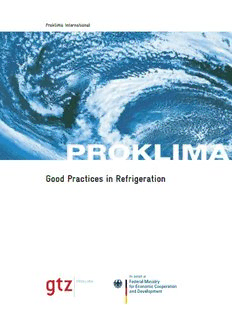
Good Practices in Refrigeration - UBF-ACA PDF
Preview Good Practices in Refrigeration - UBF-ACA
Proklima International Good Practices in Refrigeration Proklima International Good Practices in Refrigeration Published by: Deutsche Gesellschaft für Technische Zusammenarbeit (GTZ) GmbH – German Technical Cooperation – Programme Proklima Dag-Hammarskjöld-Weg 1-5 65760 Eschborn, Germany Internet: http://www.gtz.de/proklima Name of sector project: GTZ Proklima - a programme to save the ozone layer Contact person at the Federal Ministry for Economic Cooperation and Development (BMZ): Gisela Wahlen German Federal Ministry for Economic Cooperation and Development (BMZ) Environment and Sustainable Use of Natural Resources Division Bonn, Germany Email: [email protected] Editors: Dr. Volkmar Hasse (Programme Manager) Deutsche Gesellschaft für Technische Zusammenarbeit (GTZ) GmbH – German Technical Cooperation – Programme Proklima Dag-Hammarskjöld-Weg 1-5 65760 Eschborn, Germany Email: [email protected] Linda Ederberg and Rebecca Kirch GTZ Proklima c/o HEAT GmbH Zum Talblick 2 61479 Glashütten, Germany Phone: +49 6174 964575 Email: [email protected] Email: [email protected] Technical supervision/responsible for content: Rolf Hühren International Consultant Hohe Straße 23 40213 Duesseldorf, Germany Phone: +49 211 21073281 Fax: +49 211 56942349 Email: [email protected] Design: Bloomoon – Silke Rabung Print:Eschborn, March/April 2010 PROKLIMA is a programme of the Deutsche Gesellschaft für Technische Zusammenarbeit (GTZ) GmbH, commissioned by the German Federal Ministry for Economic Cooperation and Development (BMZ).PROKLIMA has been providing technical and financial support for developing countries since 1996 to implement the provisions of the Montreal Protocol on Substances that Deplete the Ozone Layer. T N E Good Practices in Refrigeration T N O C Preface .......................................................................1 Part I TOOLS AND EQUIPMENT Introduction to Part I ..................................................3 Chapter 1: Tools for Tubing (TT) .............................5 Chapter 2: Tools for Refrigerant Handling and Containment (RHC)......................18 Chapter 3: Equipment for Recovery,Recycling, Reclamation and Evacuation (RRRE)....32 Chapter 4: Measuring Instruments (MI).................41 Part II SKILLS AND OPERATION Introduction to Part II...............................................53 Chapter 5: Assembling a Refrigeration System.....55 Chapter 6: Bending,the Process..........................77 Chapter 7: Brazing,the Process...........................81 Chapter 8: Flaring,the Process............................90 Chapter 9: Domestic Refrigeration.......................95 Chapter 10: Domestic Refrigeration HC.................104 Chapter 11: Pressing,the Process..........................121 Chapter 12: Refrigerant,Recovery,Recycling and Containment in the Field............129 Chapter 13: Retrofit.............................................148 Chapter 14: Safety...............................................164 Annex Glossary ..................................................................170 Acronyms and Abbreviations ...................................175 Index......................................................................176 Acknowledgements We thank the author Rolf Huehren for his thorough compilation and detailed demonstration of how to service and maintain refrigeration systems and Daniel Colbourne for technical advice. Furthermore,we thank the following companies for their kind provision of picture material: Agramkow Fluid Systems A/S and RTI Technologies Inc.,Appion Inc., Peter M. Börsch KG, Danfoss GmbH,Fluke Deutschland GmbH,GEA Kueba GmbH,Harris Calorific GmbH,IKET – Institut für Kälte-,Klima- und Energietechnik GmbH,ITE N.V.,Ixkes Industrieverpackung e.K., Manchester Tank,Mastercool Europe,Moeller GmbH,Ntron Ltd.,Panimex,Parker Hannifin GmbH & Co.KG,Perkeo-Werk GmbH & Co.KG,Refco Manufacturing Ltd.,Rotarex,Sanwa Tsusho Co. Ltd.,Georg Schmerler GmbH & Co.KG,Testboy GmbH,Van Steenburgh Engineering Labs Inc., Vulkan Lokring Rohrverbindungen GmbH & Co.KG,Worthington Cylinders. Volkmar Hasse,Linda Ederberg and Rebecca Kirch Preface The phase-out of HCFCs and the introduction of various alternative refrigerants confronts both the servicing technicians and vocational trainers in the refrigeration and air-conditioning sector with specific problems.Refrigeration technicians are not yet sufficiently prepared to deal with the new technologies which will have to be introduced in the near future. The manual ‘GOOD PRACTICES IN REFRIGERATION’ is the second edition of a booklet jointly published by the PROKLIMA Programme of the ‘Deutsche Gesellschaft für Technische Zusammenarbeit’ (GTZ) GmbH,the Brazilian ‘Servico Nacional de Aprendizagem Industrial’ (SENAI) and the ‘Ministério do Meio Ambiente do Brazil’ (MMA) in 2004,which had been widely used as part of the training courses on ‘Best practices in refrigeration servicing and CFC conservation’, which were implemented by PROKLIMA as part of the national CFC phase-out plan in Brazil. This manual has now been updated to provide professional guidance on how to service and maintain refrigeration systems operating with new technology,e.g.ozone-friendly alternative refrigerants to CFCs and HCFCs.It addresses essential know-how on containment of HFC refri- gerants which have a high Global Warming Potential (GWP) and are already widely applied.It also provides extensive information on the safe use of natural refrigerants,such as CO,Ammonia 2 or Hydrocarbons,which are much more environmentally-friendly with zero or negligibleGWP.These efficient but still relatively little used refrigerants are in fact suitable replacements for HCFCs in all applications of refrigeration and air-conditioning equipment. Part I of this picture book addresses important tools and equipment for tubing;refrigerant hand- ling and containment;for recovery,recycling,reclamation and evacuation,as well as measuring instruments.Part II focuses on the handling of servicing and maintenance of refrigeration systems, such as brazing,flaring,recovery,retrofit and recycling. Illustrations should help the technicians to easily remember,identify and communicate elements of best practices in refrigeration. 1 Background Ozone depletion and Montreal Protocol In the 1970s,scientists discovered the dangerous impact CFCs have in the earth’s atmosphere. CFCs were used as foam blowing agents,refrigerants and solvents.It was found that they destroy the ozone layer,so that aggressive UV-B radiation can reach directly the Earth’s surface causing genetic damage in the cells of people,plants and animals.Therefore,in 1987,an international treaty was concluded at Montreal,Canada (the so called Montreal Protocol on Substances that Deplete the Ozone Layer),to prevent the ozone layer from further destruction and begin the phase- out of the use of CFCs and other ozone-depleting substances (ODS).Until November 2009,all states worldwide had signed the Protocol.They have worked effectively and successfully towards a substitution of CFCs which have been banned since1January 2010.In 2007,the treaty was adjusted to address the phase-out of HCFCs which are the last group of ODS.The refrigeration and air-conditioning sector,especially in many Article-5 countries,uses very large quantities of HCFCs and is therefore particularly relevant in the imminent HCFC phase-out. 2
Description: